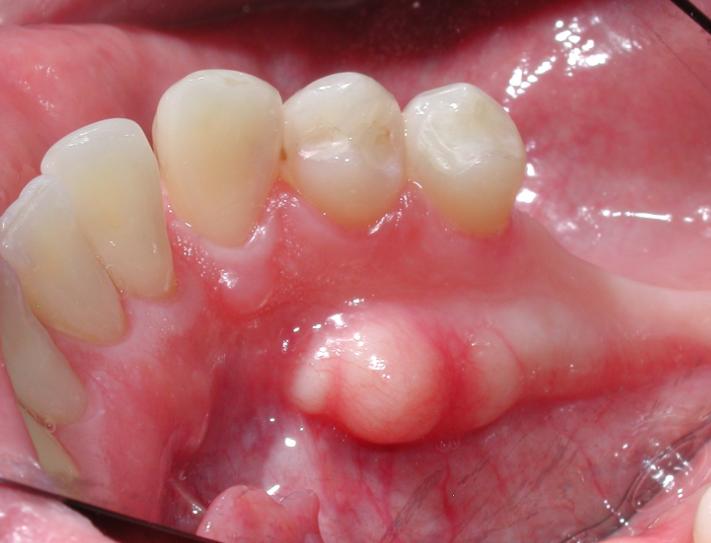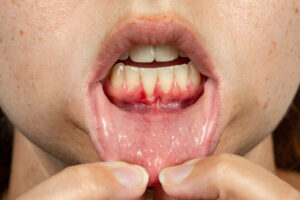Early Stage Mandibular Tori Cancer

Mandibular tori (singular: torus) are bony growths located on the inner side of the lower jaw (mandible), beneath and on the side of the tongue.
They are usually benign (non-cancerous) and often do not require treatment unless they interfere with the fit of dentures, cause discomfort, or are subject to frequent trauma.
The term “mandibular tori cancer” is not commonly used, as mandibular tori themselves are not cancerous.
Still, you may be referring to a situation where there’s a concern about cancerous changes or lesions developing in an area where mandibular tori are present.
Key Takeaways
- Mandibular tori are benign: These are harmless bony growths on the inner side of the lower jaw. They are not cancerous.
- Symptom overlap: Early-stage oral cancer and mandibular tori might share some symptoms like mouth sores and lumps.
- Key differences: Mandibular tori are typically bilateral (both sides of jaw), painless (unless injured), and hard. Cancer may be unilateral, often features color changes (red/white patches), and can cause numbness or persistent pain.
- When to see a doctor: Any persistent mouth sore, unusual lump, pain, numbness, or difficulty eating/swallowing warrants professional evaluation.
Table of Contents
In the early stages of oral cancer, including areas around the mandibular tori, symptoms might include:
- Persistent Mouth Sore: A sore in the mouth that does not heal is the most common symptom of oral cancer.
- Pain: Pain in the mouth that doesn’t go away is another common symptom.
- Lump or Thickening: A lump or thickening in the cheek, jaw, or oral soft tissues.
- White or Red Patch: The appearance of white or red patches on the gums, tongue, tonsil, or lining of the mouth.
- Difficulty Chewing or Swallowing: Difficulties in chewing, swallowing, speaking, or moving the jaw or tongue.
- Jaw Swelling: Swelling of the jaw that causes dentures to fit poorly or become uncomfortable.
- Numbness: Numbness or a feeling of loss of sensation in any area of the mouth or lips.
- Weight Loss: Unexplained weight loss can sometimes be associated with oral cancer.
These symptoms can also be caused by conditions other than cancer.
If you or someone you know is experiencing any of these symptoms, especially if they persist or worsen over time, consult a healthcare professional or a specialist in oral medicine or oral oncology for a thorough evaluation.
Early detection and treatment of oral cancers significantly improve the prognosis and the possibility of a successful treatment outcome.
Diagnosis of oral cancer, including in areas around the mandibular tori, typically involves a physical examination, review of the patient’s medical history, and may include biopsy procedures where a small sample of tissue is taken for laboratory analysis to determine if cancer cells are present.
Is it cancer or torus mandibularis?
Tori, plural for torus are benign boney growths found on the inside (tongue side) of the lower jaw or on the palate. When found on the lower jaw or mandible, they are called mandibular tori.
They are most often bilateral, on the right and left side. When found on the midline of the palate or roof of the mouth, it is referred to as a maxillary torus or torus palatinus. They can develop at any time, and will on occasion cause serious concern to those patients who are not aware of what they are and who mistake them for oral cancer.
While it is believed to be genetic, the cause of tori growth is not completely understood. They are composed of slow-growing bone and generally pose no problems for the patient. If injured, however, it can be very painful to eat or swallow.
They may pose a problem for patients who require dentures and surgical removal may be necessary. They are a hard bump or cluster of smaller bumps, light pink in color that vary in width and elevation but average about 1cm in elevation and 2cm in width or diameter.
Oral cancer is rare. Tori are far more common, found in 7-10% of Americans. Cancer is usually found in soft tissues such as the tongue or cheek. It is most often red in color and asymetrical, meaning it grows on one side of the mouth.
Cancer of the lower jaw may cause numbness of the lower lip or hard swelling of the lymph nodes under the angle of the mandible. Tori are painless unless injured, have no lymph node involvement and cause no numbness or tingling of the tongue.
What are the signs and symptoms of oral cancer?
Oral cancer refers to cancer that develops in any part of the mouth. It can occur on the lips, tongue, cheeks, floor of the mouth, hard and soft palate, sinuses, and pharynx (throat), and can be life-threatening if not diagnosed and treated early.
Here are some common signs and symptoms of oral cancer:
- Swellings/thickenings, lumps or bumps, rough spots/crusts/eroded areas on the lips, gums, or other areas inside the mouth.
- White, red, or speckled (white and red) patches in the mouth.
- Bleeding in the mouth without any apparent reason.
- Unexplained numbness or pain/tenderness in any area of the face, mouth, or neck.
- Persistent sores on the face, neck, or mouth that bleed easily and do not heal within two weeks.
- Difficulty chewing or swallowing, speaking, or moving the jaw or tongue.
- Hoarseness, chronic sore throat, or change in voice.
- Ear pain.
- A change in the way your teeth or dentures fit together — a change in your bite.
- Dramatic weight loss.
- A lump or mass in the neck — for some individuals, this may be the first sign of oral cancer.
These symptoms can also be caused by other, less serious conditions. However, if you notice any of these symptoms persisting for more than two weeks, it is crucial to see a healthcare professional for a thorough examination and diagnosis.
Early detection of oral cancer significantly increases the chances of successful treatment.
5 things to know about the torus mandibularis
The torus mandibularis is a bony growth in the mandible along the surface nearest to the tongue.
These growths are generally benign and often present no cause for concern, but they can be interesting from both a dental and an anthropological perspective.
Here are eight things to know about the torus mandibularis:
- Definition and Location: A torus mandibularis is a bony protrusion on the inner surface of the lower jaw, typically near the premolars and above the location where the mylohyoid muscle attaches to the mandible.
- Prevalence and Variation: The occurrence of torus mandibularis varies widely among populations and is influenced by genetic, environmental, and dietary factors. It is more common in some ethnic groups than others.
- Cause and Development: The exact cause of torus mandibularis is not fully understood, but it is believed to be a combination of genetic predisposition and environmental factors, such as diet and physical stress on the jaw.
- Symptoms and Detection: Torus mandibularis is usually asymptomatic and is often discovered incidentally during dental exams or X-rays. In some cases, it can cause discomfort or interfere with the fitting of dentures.
- Potential Complications: While generally not harmful, large tori can lead to issues such as irritation, difficulty with oral hygiene, or interference with the placement of dental prostheses.
- Treatment Options: No treatment is necessary for torus mandibularis unless it causes discomfort, interferes with the function of the mouth, or complicates dental procedures. In such cases, surgical removal may be considered.
- Surgical Considerations: If removal is necessary, it is typically performed by an oral surgeon under local anesthesia. The procedure involves carefully excising the bony growth and smoothing the underlying bone.
- Post-Surgical Care and Recovery: Recovery from surgery to remove a torus mandibularis involves managing pain and preventing infection. Patients are usually advised to follow a soft diet and maintain good oral hygiene during the healing process.
Do you want your torus mandibularus gone? Read more about Mandibular tori removal.
Are mandibular tori cancer?
No, mandibular tori are not cancer. They are benign (non-cancerous) bony growths on the inner side of the lower jaw. Find out more about what is causing your mandibular tori: What causes a Bump on the Roof of Mouth?
Should I worry about mandibular tori?
Generally, no need to worry about mandibular tori as they are benign and usually don’t require treatment unless they cause discomfort or interfere with oral functions.
Does mandibular tori alter your face in a negative way?
Mandibular tori typically do not alter your facial appearance negatively, as they develop inside the mouth along the jawbone.
Fact Checked
Our dedicated team rigorously evaluates every article and guide to ensure the information is factual, up-to-date, and free of bias.
Updated Regularly
We update our articles and reviews regularly to ensure you have access to the latest data in the dental industry.
The content on Dental3DU’s blog is intended for educational purposes only. This information should not be relied upon as professional medical counsel. Be sure to always consult with your dentist about the dangers and benefits of any medication, treatment or procedure.







